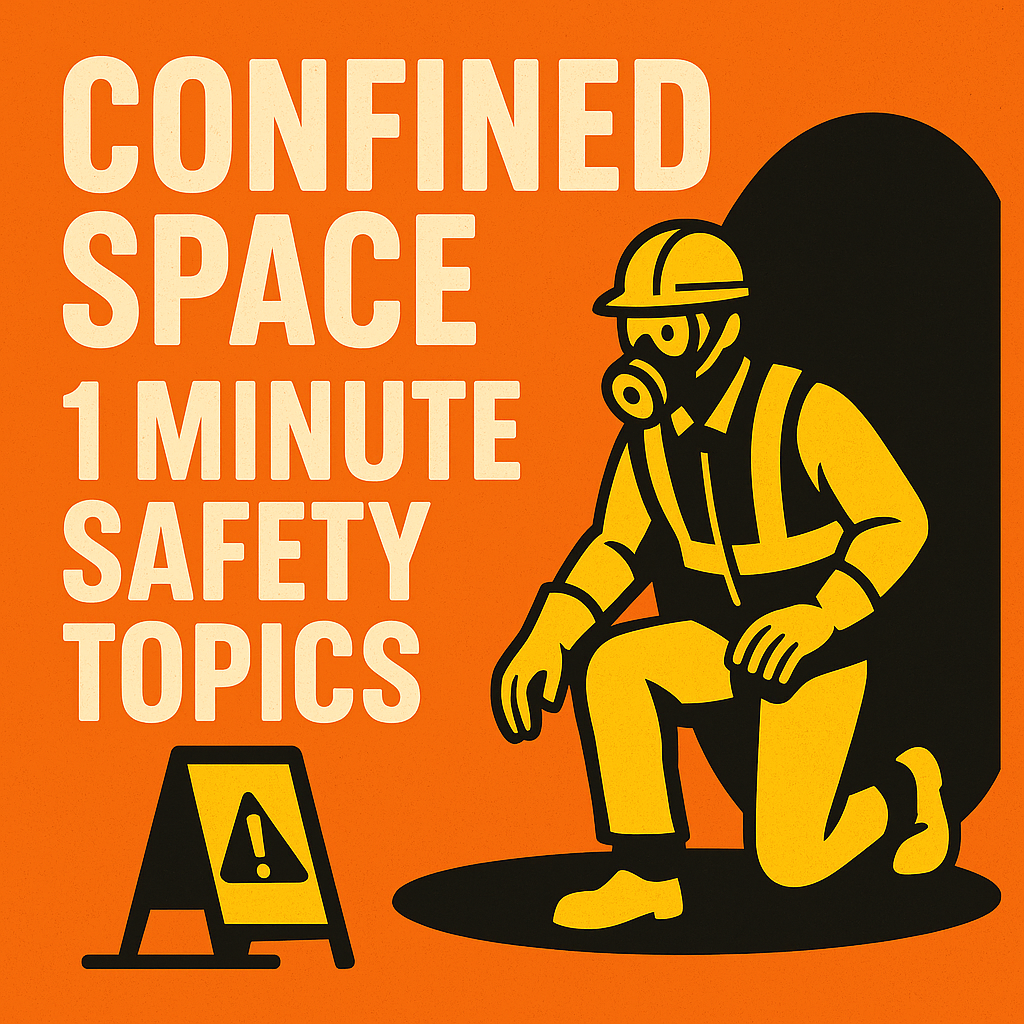
Confined Space 1 Minute Safety Topics
Confined spaces are some of the most dangerous places to work in any industry. Think of storage tanks, silos, sewers, manholes, and pipelines—these are all confined spaces that pose serious risks. Every year, workers lose their lives because they entered without proper precautions. The tragedy? Most of these deaths are preventable with awareness and preparation.
This is where 1-minute safety talks come in. They’re quick, practical reminders that help workers focus on key confined space hazards before starting work. In this guide, we’ll explore why confined space work is risky, the benefits of quick talks, and the top 10 safety topics to cover.
What Are 1-Minute Safety Topics?
A 1-minute safety topic is a short discussion that addresses one hazard or control measure at a time. These talks:
- Keep workers alert before high-risk tasks.
- Reinforce safe habits in just 60 seconds.
- Encourage active participation through simple questions.
Unlike long training sessions, these quick reminders are easy to deliver daily and highly effective.
Why Confined Space Work Is Risky
Confined spaces are defined by limited entry/exit, restricted airflow, and dangerous atmospheres. Risks include:
- Oxygen deficiency – Breathing difficulties or suffocation.
- Toxic gases – Hydrogen sulfide, carbon monoxide, methane, etc.
- Flammable atmospheres – Risk of explosion.
- Engulfment – Workers buried in loose material.
- Limited escape routes – Making emergencies deadly.
Because of these risks, OSHA 29 CFR 1910.146 and other regulations worldwide set strict entry requirements.
Benefits of 1-Minute Confined Space Talks
- Daily hazard awareness – Workers stay mindful of invisible dangers.
- Improved teamwork – Everyone knows their role in entry operations.
- Reinforcement of procedures – Reminds workers not to skip steps.
- Life-saving habits – A single reminder can prevent a fatal mistake.
Top 10 Confined Space 1-Minute Safety Topics
Here are the most effective reminders you can deliver quickly on-site:
Topic 1: Permit-to-Work Requirement
Never enter a confined space without a valid permit. It confirms all precautions—like testing, ventilation, and rescue plans—are in place.
Message: “No permit, no entry.”
Topic 2: Atmospheric Testing
Always test for oxygen levels, flammable gases, and toxins before entry. Re-test continuously during work.
Reminder: “If the air isn’t tested, don’t trust it.”
Topic 3: Ventilation
Use blowers or fans to supply fresh air. Never rely on natural airflow inside confined spaces.
Topic 4: PPE for Confined Spaces
Depending on hazards, PPE may include respirators, harnesses, gloves, helmets, and protective clothing.
Topic 5: Attendant Role
An attendant must stay outside the confined space to monitor conditions and initiate rescue if needed.
Message: “No attendant, no entry.”
Topic 6: Communication
Maintain constant communication between the entrant and attendant—via radios, hand signals, or visual checks.
Topic 7: Isolation of Energy Sources
Lockout/Tagout (LOTO) all mechanical, electrical, or hydraulic systems connected to the space before entry.
Topic 8: Engulfment Hazards
Spaces with loose grain, sand, or liquids can bury workers quickly. Control these risks before entry.
Topic 9: Emergency Rescue Plan
Rescue equipment must be ready—tripods, winches, SCBAs. Untrained workers must never attempt rescue.
Reminder: “Don’t add victims to the emergency.”
Topic 10: Worker Fitness and Awareness
Workers must be alert, trained, and medically fit before entry. Fatigue or distractions increase risks.
How to Deliver Confined Space Safety Talks Effectively
- Keep it simple and under 60 seconds.
- Focus on one hazard at a time.
- Use real-life incidents to grab attention.
- Ask workers: “What’s the first thing you check before entering?”
Mistakes to Avoid
- Rushing into confined spaces without full precautions.
- Giving overly technical talks that confuse workers.
- Skipping daily reminders—complacency kills.
Conclusion
Confined spaces don’t forgive mistakes. A 1-minute safety talk is one of the best defenses against tragedy. By reinforcing permits, testing, attendants, and emergency plans, you make sure workers don’t just enter safely—they also come out alive.
Remember: “Safety in confined spaces begins before you step inside.”
Excavation 1 Minute Safety Topics
Material Lifting 1 Minute Safety Topics
Electrical 1 Minute Safety Topics
Hot Work 1 Minute Safety Topics
Work at Height 1 Minute Safety Topics
FAQs
1. What is the biggest confined space hazard?
Oxygen deficiency, followed closely by toxic or flammable gases.
2. Do I need a permit for every confined space?
Yes, unless it’s reclassified as non-permit after thorough evaluation.
3. How often should the air be tested?
Continuously, especially if conditions can change.
4. Can attendants enter confined spaces?
No. Their role is to stay outside and monitor.
5. What’s the golden rule of confined space entry?
Never enter without a permit, testing, and rescue plan in place.